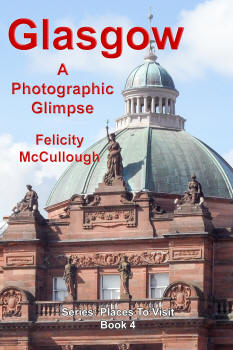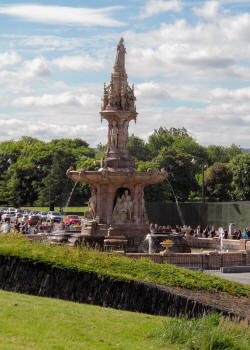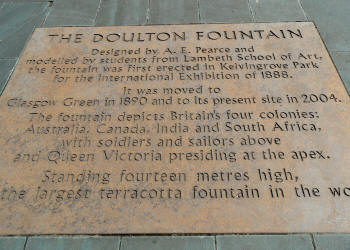The Doulton Fountain
The Doulton Fountain
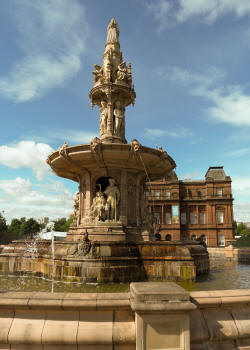
The Doulton Fountain Rear View
Looking toward The People's Palace
Felicity McCullough Copyright 2013
Doulton Fountain was erected in Kelvingrove Park.
Built to commemorate the 1887 Golden Jubilee of Queen Victoria by the Royal Doulton Company, Lambeth and Sir Henry Doulton. It was also designed to be a commemoration of Britainís achievements.
International Exhibition of 1888
The Doulton Fountain was used as a focal point in the International Exhibition of 1888, held in Kelvingrove Park. Glasgow at the time, was the British Empireís second city. The International Exhibition was planned to rival the famous Exhibitions, which had been held in London.
The Exhibition attracted 6 million visitors. It raised £42,000, which was enough to build Kelvingrove Art Gallery and Museum.
Glasgow Green Fountain
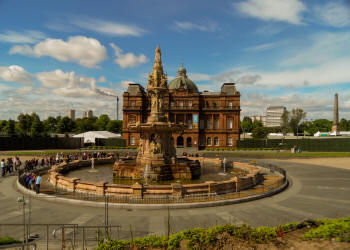
Doulton Fountain, Glasgow Green
Felicity McCullough Copyright 2013
The Doulton Fountain was moved to Glasgow Green about 100 years ago. From being next to the Bandstand in Kelvingrove Park, the entire fountain was transported two and a half miles, to a new location on Glasgow Green.
The fountain was then further moved within Glasgow Green, to its current location, which is now outside the front entrance of the Peopleís Palace.
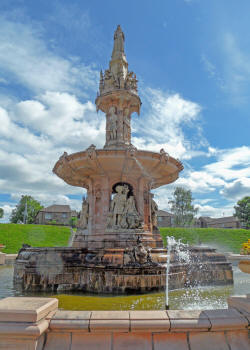
Front Profile, The Doulton Fountain
Felicity McCullough Copyright 2013
The fountainís height from its base, to its apex is 46 feet. The fountainís water base spans some 70 feet in diameter, which possibly makes it the largest terracotta fountain in the world.
Built around a terracotta iron frame and central column, the fountainís sculptures display five distinctive tiers.
Terracotta was chosen, as it may be worked quickly, can produce detailed delicately defined shapes and sculptures.
Terracotta is also durable and weather-resistant, although susceptible to frost.
When lightening destroyed the statue of Queen Victoria, it proved challenging to restore, as the original Queen Victoria Statueís moulds had been broken. The terracotta had to be completely recast around the fountainís iron frame.
The Crest of Glasgow adorns the water basin.
Doulton Fountain Designer
Felicity McCullough Copyright 2013
The designer of the Doulton Fountain was Arthur Edward Pearce. Arthur Peace designed the fountain, with the French Renaissance style in mind.
It was restored to the original specifications by 2005, at a cost of 2 million pounds from National Lottery and Scottish Heritage Funds.
A lot of the original sculptural group embellishments of the fountain, had been destroyed by vandalism years earlier. The fountain over the centuries had also deteriorated due to much neglect and lack of investment by Glasgow Council.
The restoration terracotta project was undertaken by skilled craftsmen at Hathern Terracotta. Hathern Terracotta undertook research to try to faithfully represent the original designs. This was challenging as heads were missing. They retained as much of the original as possible, integrating the new onto the old, to recreate what we see today.
Doulton Fountain Sculptors
The sculptors of the statues were John Broad, Herbert Ellis, Arthur Edward Pearce, Frederick Pomeroy and William Silver Firth.
Probably there were also some student assistants, who also worked on the project and who would have been supervised by William Firth.
Queen Victoriaís Statue
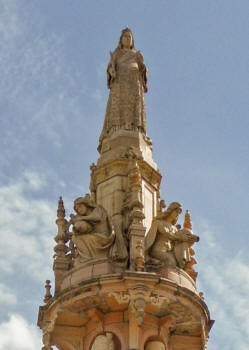
Queen Victoria And Maidens Doulton Fountain
Felicity McCullough Copyright 2013
The Queen Victoria Statue which sit on the apex was the work of John Broad. The queen is dressed, as the Empress of India in a lace dress, wearing the Imperial Crown. Her Majestyís statue stands with orb and sceptre in hands.
Maidens
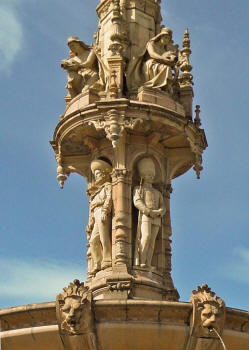
The Sentries, Doulton Fountain
Felicity McCullough Copyright 2013
Below the Queen are four maidens who are kneeling, around four ornate buttresses. From their pitchers water flows into the base. They are wearing transparent dresses.
Sentries
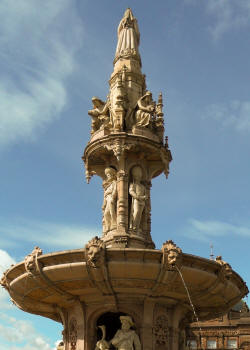
The Upper Doulton Fountain Basin
Felicity McCullough Copyright 2013
Below the maidens are four sentries, standing in recessed arches. They represent the Regiments of Scotland, England, Ireland and the Royal Navy.
The Scottish sentry is a Black Watch Highlander.
The English statue is of a Grenadier Guardsman.
The next statue is of an Irish Fusilier.
The last statue is of a Royal Naval Sailor, which had to be recreated from old photos, as the head had long since disappeared through vandalism, before the fountain was restored.
The sentriesí uniforms contain much attention to detail.
The Colonies
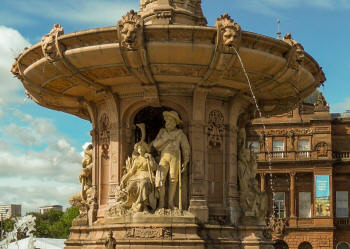
The South African Statue Group, Dolton Fountain
Felicity McCullough Copyright 2013
Four groups of figures are sited within open arches on the lower tier, representing the territory of the four continents of the British Empire.
There is a male and female figure wearing national costume. The group is accompanied by artefacts of history, industry and agriculture of the country they represent.
The groups depicts Britain's four colonies of Australia, Canada, India and South Africa.
The Canadian representation was modelled by William Silver Firth. The South African was by Herbert Ellis. The Australian by Frederick Pomeroy and India modelled by John Broad.
The Indian Empire Group Statue
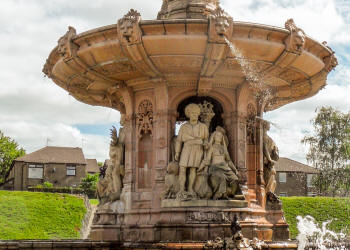
The India Statue Group, Dolton Fountain
Felicity McCullough Copyright 2013
Modelled by John Broad, the India group includes a statue of an armed man in a turban, representing its military.
A female hand holds a scroll representing literature and is accompanied by artefacts representing the arts and other manufacturing industries.
The Canadian Group Statue
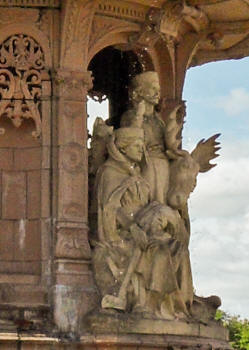
The Canada Statue Group, Dolton Fountain
Felicity McCullough Copyright 2013
Modelled by William Silver Firth, the Canadian statue is of a male trapper. He holds the head of a moose ox and has a beaver at his foot.
A female statue sits on the stump of a fallen tree, holding a shaft of wheat and a felling axe at her side. Coal and a minerís pickaxe are at her feet.
South Africa Group Statue
The group South Africa statues were modelled by Sculptor Herbert Ellis. A European male farmer stands armed heavily, over his crops.
Next to him is a seated native woman. Her hand rests on a spade, representing mineral resources. Adjacent is maize and the vine, representing agriculture. The ostrich statue and wool, imply husbandry.
Australia Continent
Modelled by Frederick Pomeroy, the male gold prospector, rests seated and leaning on his spade.
The female standing, holds a sheaf of wheat, with the other hand resting on a horned sheep. A vine grows beside her. Both represent the wool and wine industries.
Doulton Fountain Plaque Inscription
Felicity McCullough Copyright 2013
Designed by A E Pearce and
modelled by students from Lambert School of Art,
the fountain was first erected in Kelvingrove Park,
for the International Exhibition of 1888.
It was moved to Glasgow Green in 1890 and to its present sitein 2004.
The Fountain depicts Britain's four colonies:
Australia, Canada, India and South Africa,
with Soldiers and sailors above
and Queen Victoria presiding at the apex.
Standing fourteen metres high, it is the largest,
the largest terracotta fountain in the world
Templeton Business Centre
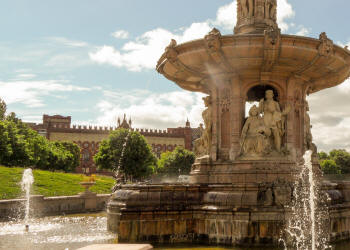
Looking Towards The Templeton Business Centre
Felicity McCullough Copyright 2013
The very ornate an architecturally interesting Templeton Business Centre building may be seen in the background to the Doulton Fountain. The original use of the building was as a carpet factory. It was constructed between 1888 and 1892 and designed by William Leiper.
Summary of my visit
My visit to the Peopleís Palace was greeted by the Doulton Fountain. Its prominence could not be missed. The flowing water from the ducts of the fountain was clearly delighting the youngsters, who had just arrived from a local school. The sunlight glistened in the water.
The warmth of the red terracotta matched the colours of the brickwork of the Peopleís Palace and the nearby Templeton buildings. The fountain looked like it had always been there since Victorian times.
It is only now, having researched the history of the Doulton Fountain that I learnt that the monument had only recently been restored to its former glory, and at a great cost.
I wonder what the Victorians thought would happen to the fountain over the years. Would they have considered how society would change over the last century? Did they consider how money would be found to maintain the upkeep of such a monument, especially as flowing water is involved?
They certainly would have been shocked at the level of vandalism the fountain has endured, since the Victorians first conceived the idea.
I also wonder how our generation considers how the Fountain will be maintained, over the next century. Where will the money needed for its upkeep be found?
That said, the craftsmen who have restored the beauty of the fountain, have created something worth lingering at. The Doulton Fountain is worth visiting in its own right.
I very much enjoyed photographing the Fountain on a sunny day in June. I have included photographs of the Fountain in my book, ĎGlasgow A Photographic Glimpseí. The book is available from Amazon and good book stores, or by clicking the buy button below.
 |
 |
 |
|
 |
 |
 |
|
 |
 |
 |
|
 |
 |
 |
|
 |
Articles: -
Doulton Fountain Links: -
Glasgow Green, Doulton, Doulton Fountain, Fountain, People's Palace, Glasgow, People Glasgow, Palace Glasgow, Park Glasgow, Glasgow City, Green Fountain, Doulton, Doulton fountain, Doulton fountain Glasgow green, fountain memorial, garden fountain UK, Glasgow city council garden maintenance, Glasgow green, Glasgow landmarks, green fountain, memorial fountain, memorial fountains, palace of the people, people s palace, peoples palace, peoples palace Glasgow, terra cotta fountain, Victorian fountain, Victorian fountains, Victorian garden fountains, winter gardens Glasgow

